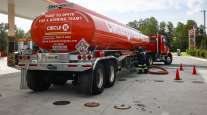Tire Makers Alter Treads to Save Fuel; Fleets Concerned Over Traction Impact
This story appears in the Dec. 3 print edition of Transport Topics.
Tire manufacturers say they are altering tread designs, block patterns and shoulder designs to comply with the SmartWay program and greenhouse-gas and fuel-efficiency rules. Some fleet managers, however, said those changes mean other performance areas will be compromised.
Mark Stets, eastern area director of maintenance for Con-way Freight, Ann Arbor, Mich., said, “Generally, if a tire wears longer, it is more fuel efficient, but it is going to be a harder composition and it might not bite the ground as [well], so you sacrifice some traction.”
For A. Duie Pyle, West Chester, Pa., traction is king.
“Fuel efficiency is a concern, but we can’t make that our No. 1 selling point on buying a tire,” said Dan Carrano, the fleet’s director of fleet maintenance. “First we look for adequate traction in all drive conditions — snow, rain, city or highway. Second is durability. In the pickup-and-delivery operation, there is a lot of twisting and turning and high scrub where you’re actually chafing the tread off the tire.”
Tim Gordon, director of maintenance for KKW Trucking Inc., Pomona, Calif., said mileage is his top priority when spec’ing tires for the fleet’s 300 trucks and 900 trailers, but he knows a tire’s design can only do so much.
“Educating your people and monitoring operations is as, or more, important than the exact tread design,” Gordon said, adding that he encourages drivers to check tire pressures and does complete alignments to keep the maximum amount of the tire touching the road at all times.
“Even keeping a good greased fifth wheel makes a difference on how your trailing equipment pulls, especially if you’re pulling doubles,” he said.
Despite the trade-offs, opting for fuel-efficient tires isn’t a choice for many fleets. As of Jan. 1, California has mandated that tractors built in 2010 or earlier that pull 53-foot dry van or refrigerated trailers must use SmartWay-verified low-rolling-resistance tires or retreads.
SmartWay is a partnership between the trucking industry and the Environmental Protection Agency to promote products and practices that reduce fuel consumption and fuel emissions.
“The government is now involved in that compromise and telling you what your rolling resistance needs to be. The rest is managing the compromise between wear and traction,” said Paul Crehan, director of product marketing, Michelin North America.
In addition, Chris Moore, vice president of operations for Bear Trucking Inc., San Bernardino, Calif., said, “A lot of our customers are requiring us to be SmartWay-certified.”
Bear Trucking uses tires made by Yokohama Tire Corp., Fullerton, Calif.
Manufacturers said they are responding to fleets’ request for fuel-efficient tires and working to minimize the trade-offs.
“We’re desperately trying to build a higher-traction tire for these customers that will have good resistance to regular wear, good rolling resistance and good removal miles,” said Guy Walenga, director of engineering, commercial products and technologies for Bridgestone Commercial Solutions, Nashville, Tenn.
Bridgestone has redesigned block patterns within its tread to minimize the rate of wear and improve rolling resistance. New tread designs released earlier this year include support platforms within the design that sit between larger blocks of tread to eliminate movement of the blocks.
“The tread design on the drive tire is similar to the tire it is replacing, but it has different shapes on the independent blocks,” Walenga said. “It is the movement of the blocks as the footprint kicks out that will wear. In some of the void areas, we have support blocks [that] connect to the main blocks to keep them from moving too much.”
Clint Covey, truck and bus development engineer at Hankook Tire America Corp.’s Akron Technical Center, said he is seeing an overall trend toward complex intralocking curved geometry on tires.
“You can use more curves and still keep the tread block very stiff when it goes through the footprint because of this complex geometry that is inside of the curve,” Covey said. He added that because of SmartWay, within the past two years Hankook has revamped two of its existing drive tires and added a new segment to its application-specific tires.
As part of the tread pattern, drive tires have an outer rib with either a closed shoulder or open shoulder.
Donn Kramer, director of product marketing innovation for Goodyear Commercial Tire Systems, said, “The new drive tires used in longhaul and regional applications are generally a lug — or traction type — design, either open shoulder for aggressive traction, or closed shoulder for more mileage and balanced for traction and fuel economy.”
Closed-shoulder tires also can help in local applications, where tires frequently are scuffed on curbs, which is why Bear Trucking uses closed-shoulder designs.
“The wheels are turning all the time and there is a lot of wear and tear on the edges,” Moore said.
Wes Smith, maintenance manager at Con-way Truckload, only considers tires that are SmartWay approved, but he looks for other features as well, such as how well siping — cuts within the tread — can remove water.
“An open-shoulder tire does the best job of that, but most of the low-rolling-resistance tires are a closed shoulder. You have to look at the angles they use in the tread block,” Smith said.
Smith also said he looks for decoupling grooves because they help to guarantee even wear.
“If you look at the face of the tire, typically the outer tread block is an inch wide and they’ll cut a groove and leave a quarter of an inch around the outside. It relieves different effects of when you’re turning and moving or rolling down the road; it affects how it releases from the pavement,” he said.
But carriers said they not only are looking for tread patterns that are fuel efficient and durable, they also want designs that can help to improve the life of the tire by keeping debris from damaging both the tire and the casing.
Bear Trucking’s Moore said he has seen more rock damage to his tires lately and is paying more attention to rock-ejector designs in the tread.
“Rocks literally grind in and cause damage all the way down to the steel belt. That little stone can be pretty expensive,” Moore said.
One of Continental Commercial Vehicle Tires’ anti-stone retention systems consists of a series of pyramids cut at angles in the groove that expel small stones. The technology works by either repelling the stones or preventing them from reaching the bottom of the groove, where damage can occur.
Bridgestone uses what it calls stone-rejector technology at the base of the groove along with the angle of the walls of the tread.
“Those are all part of the design, so we don’t trap the stones — or if we do, they don’t stay in long enough to do any damage,” Bridgestone’s Walenga said.
Engineers at Michelin also are incorporating more ribbed patterns with siping, which helps with wear.
“There are blocks for rigidity when running and teardrop siping so as the tire wears, it creates a new groove in the tread pattern. The trick is if you put simple cuts in the tread, the tread loses its rigidity and that will create irregular wear and catch stones. We were able to have the sipes lug on each other,” Crehan said.
Bridgestone also uses ribbed patterns on steers and utilizes a defense groove, which sometimes is called a decoupling groove. Basically, the grooves are a small rib on the outer edge of the tire that helps to protect the ribs next to it.
“The design of the defense groove base is unique in that the groove comes out of the top, so it allows it to be a little more flexible to do the job it is supposed to do, but not so much that it gathers debris or will rip,” Walenga said.
Libor Heger, director of research and development for Continental, said that the manufacturer is embracing narrow grooves and shallower tread design on steer tires, which also requires changing the tire’s compound.
“You don’t go as deep as you used to go and the grooves are not as wide as they used to be,” he said. “If you go to lower tread depth, then we have to provide compounds that provide the mileage the customer used to have before.”
On its highest-technology tires, Michelin is replacing some of the tread rubber beneath the grooves with rubber that generates less heat to improve rolling resistance, Crehan explained, noting the trade-off that occurs.
“The properties of the material that allow you to bend without generating heat aren’t as good with traction,” he said.
Fleets constantly are testing tires to find the best fit for their applications, as well as testing multiple manufacturers and multiple designs within manufacturers.
“At any given point and time, we’ll have about 4,000 tires in evaluation in our fleet. That is both new tires and retread configurations. We’re looking at a combination of new compounds and new tire tread designs,” said Scott Perry, vice president of supply management for Ryder System’s Fleet Management Solutions, Miami.
Perry estimates that SmartWay tires provide a 4% increase in fuel economy.
With more than 160,000 units within the fleet and more than 120 different configurations of tires within its network, Ryder tests for the life of steer and drive tires.
“If it is a trailer, we can see a tire that will last six to eight years. We’ll look at the first year and then extrapolate what the life expectancy should be,” Perry said.
After testing multiple tires, Stets of Con-way Freight began spec’ing a new fuel-efficient drive tire from Goodyear two years ago.
“We’ve improved our drive-tire wear by 50%, and we’re going to get about a half-a-percent increase in fuel economy,” he said.
Stets said he tests tires for at least a year.
“If you don’t take the time up front, you’re going to pay for that mistake a long time afterward,” Stets said.




